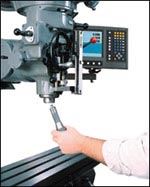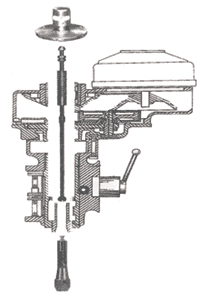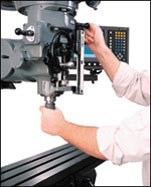Quicker Tool Change For Mills
This article examines a retrofitted mechanical drawbar system with a preset die spring that enables an operator to manually do what a machining center does automatically--change tools quickly.
Share




OK. You’ve installed scales on your knee or bridge mill, maybe even installed a CNC and servo package to automate the machine tool. When the dust from all this upgrading settles, you’re still looking at a potential productivity weak link in changing tools.
A new quick change tooling system from Acu-Rite (Jamestown, New York) may be a reliable, cost effective way to upgrade the tool change time on your R-8 spindle knee or bed mill. Called the Mach-1, it’s a retrofitted mechanical drawbar system with a preset die spring that enables an operator to manually do what a machining center does automatically—change tools quickly.
The drawbar system uses only 0.25 inch of vertical movement to capture or release a collet. The die springs generate a gripping force equivalent to a power drawbar system but without the risk of damaging a collet or the taper of the R-8 spindle from over torquing.
On this new system, the collet adheres closer to the collet taper and pulls the sleeve around it, forcing the face of the collet against a thrust nut. This captures the tool within the collet and prevents any tendency of the collet to "bellmouth." Bellmouth occurs when excessive torque causes the collet to deflect in the center, which results in an opening up at the collet end—like a bell. The result of bellmouthing is a reduction in the collet’s ability to grip the full surface area of the tool shank.
To actuate the Mach-1 drawbar, the operator simply lifts and releases the quill handle. This short move disengages the cutter from the drawbar, allowing it to slip out of the spindle.
The same motion is used to load a new tool. Operation of the quill is unaffected by the drawbar release mechanism. The system does require use of specially adapted toolholders, which have a knob for the drawbar to clamp on.
An advantage of the drawbar system is its consistent grip. Variability of grip from operator to operator is eliminated with this system. The drawbar spring grips each cutter with the same force each time.
Another advantage, according to the company, is that preset tools generally don’t need to be reset after a tool change. The drawbar works on the toolholder keeping toolholders, collets and cutters set up as they came off the presetter. Basically tool wear is the only dimensional deviation from preset specifications.
Acu-Rite sees this new system as an alternative for power drawbars. The company has created a ready-to-go package that includes the drawbar system and an assortment of toolholders and collets. These units can be field retrofitted. According to the company, pay back of 17 days has been reported.
Many shops are looking for cost-effective ways to automate their processes without sacrificing the versatility of the knee or bed mills in their shops. This new drawbar system may be a way to help make your milling department more productive with a small investment. MMS
Related Content
-
Orthopedic Event Discusses Manufacturing Strategies
At the seminar, representatives from multiple companies discussed strategies for making orthopedic devices accurately and efficiently.
-
Briquetting Manufacturer Tools Up for Faster Turnaround Times
To cut out laborious manual processes like hand-grinding, this briquette manufacturer revamped its machining and cutting tool arsenal for faster production.
-
Selecting a Thread Mill That Matches Your Needs
Threading tools with the flexibility to thread a broad variety of holes provide the agility many shops need to stay competitive. They may be the only solution for many difficult materials.


























.jpg;maxWidth=300;quality=90)

